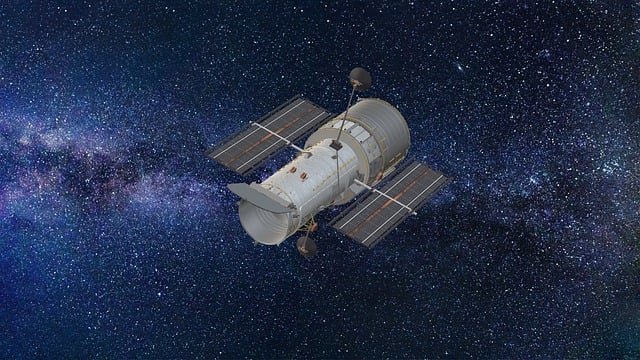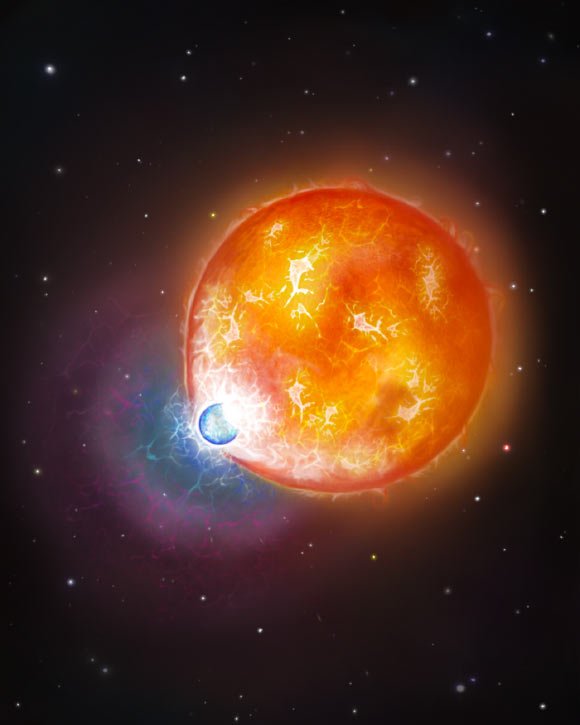White dwarfs are the dense cores left behind when stars exhaust their fuel and collapse. They are Earth-sized stellar embers weighing typically half as much as the Sun, made up of carbon-oxygen cores with surface layers of helium and hydrogen. Using far-ultraviolet data from the NASA/ESA Hubble Space Telescope, astronomers have discovered atmospheric carbon in the long-known ultramassive white dwarf WD 0525+526, and also found that the total masses of hydrogen and helium in the star’s atmosphere are substantially lower than those expected from single-star evolution, implying that WD 0525+526 is a merger remnant.
Illustration of a merger of a white dwarf with sub-giant star (size not to scale) that would have occurred in past. Image credit: Snehalata Sahu / University of Warwick.
WD 0525+526 is located approximately 130 light-years away in the constellation of Auriga.
With a mass 20% larger than our Sun, this white dwarf is considered ultramassive, and how this star came to be is not fully understood.
Such a white dwarf could form from the collapse of a massive star. However, ultraviolet data from Hubble revealed WD 0525+526 to have small amounts of carbon rising from its core into its hydrogen-rich atmosphere — suggesting this white dwarf did not originate from a single massive star.
“In optical light, WD 0525+526 looks like a heavy but otherwise ordinary white dwarf,” said University of Warwick astronomer Snehalata Sahu.
“However, through ultraviolet observations obtained with Hubble, we were able to detect faint carbon signatures that were not visible to optical telescopes.”
“Finding small amounts of carbon in the atmosphere is a telltale sign that this massive white dwarf is likely to be a remnant of a merger between two stars.”
“It also tells us there may be many more merger remnants like this masquerading as common pure-hydrogen atmosphere white dwarfs.”
“Only ultraviolet observations would be able to reveal them to us.”
Normally, hydrogen and helium form a thick barrier-like envelope around a white dwarf core, keeping elements like carbon hidden.
In a merger of two stars, the hydrogen and helium layers can burn off almost completely as the stars combine.
The resulting single star has a very thin envelope that no longer prevents carbon from reaching the surface — this is exactly what is found on WD 0525+526.
“We measured the hydrogen and helium layers to be ten-billion times thinner than in typical white dwarfs,” said University of Warwick astronomer Antoine Bédard.
“We think these layers were stripped away in the merger, and this is what now allows carbon to appear on the surface.”
“But this remnant is also unusual: it has about 100,000 times less carbon on its surface compared to other merger remnants.”
“The low carbon level, together with the star’s high temperature (nearly four times hotter than the Sun), tells us WD 0525+526 is much earlier in its post-merger evolution than those previously found.”
“This discovery helps us build a better understand the fate of binary star systems, which is critical for related phenomena like supernova explosions.”
Adding to the mystery is how carbon reaches the surface at all in this much hotter star.
The other merger remnants are later in their evolution and cool enough for convection to bring carbon to the surface. But WD 0525+526 is far too hot for that process.
Instead, the authors identified a subtler form of mixing called semi-convection, seen here for the first time in a white dwarf.
This process allows small amounts of carbon to slowly rise into the star’s hydrogen-rich atmosphere.
“Finding clear evidence of mergers in individual white dwarfs is rare,” said University of Warwick’s Professor Boris Gänsicke.
“But ultraviolet spectroscopy gives us the ability to detect these signs early, when the carbon is still invisible at optical wavelengths.”
“Because the Earth’s atmosphere blocks ultraviolet light, these observations must be carried out from space, and currently only Hubble can do this job.”
“As WD 0525+526 continues to evolve and cool, it is expected that more carbon will emerge at its surface over time.”
“For now, its ultraviolet glow offers a rare glimpse into the earliest stage of a stellar merger’s aftermath — and a new benchmark for how binary stars end their lives.”
The findings appear today in the journal Nature Astronomy.
_____
S. Sahu et al. A hot white dwarf merger remnant revealed by an ultraviolet detection of carbon. Nat Astron, published online August 6, 2025; doi: 10.1038/s41550-025-02590-y



